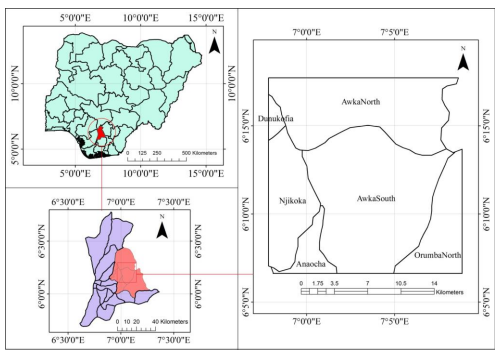
Downloads
Keywords:
Remote Sensing-Guided Land Cover and Land Use Analysis as a Preliminary Step for Assessing Land Degradation and Its Impact.
Authors
Abstract
This study employed remote sensing to conduct a land cover and land use analysis of Awka Capital Territory in Anambra State, Nigeria, with a primary focus on its role as a precursor to assessing land degradation and its consequences. The findings revealed a noteworthy increase in the urban area, which expanded from 27.92% to 31.19% (an area of 14,437.68 hectares) between 1990 and 1999, further growing to 33.67% (covering 15,586.73 hectares) between 1999 and 2008, and ultimately reaching 37.24% (covering 17,237.45 hectares) between 2008 and 2017. The trend analysis indicated an annual rate of change of 0.62% between 1990 and 1999, 0.43% between 1999 and 2008, and 0.56% between 2008 and 2017 in the urban area.Transition analysis demonstrated that during the first period (1990-1999), urban area gained 1,272.73 hectares from vegetation and 242.5 hectares from open space. Similarly, between 1999 and 2008, urban area gained 1,000 hectares from vegetation and 149.05 hectares from open space. In the final epoch (2008-2017), urban area gained 1,068.27 hectares from vegetation and 582.45 hectares from open space.Predictive analysis for the future urban development dynamics of Awka Capital Territory in 2048 projected an increase in urban areas from 35.45% to 49.41%, equivalent to an expansion from an area coverage of 17,798.44 hectares to 22,871.51 hectares. This study recommends the adoption of this approach as a valuable tool for urban development planning and decision-making, emphasizing its utility in addressing land degradation and its associated impacts.
Article Details
Published
Issue
Section
License

This work is licensed under a Creative Commons Attribution-NonCommercial-ShareAlike 4.0 International License.

